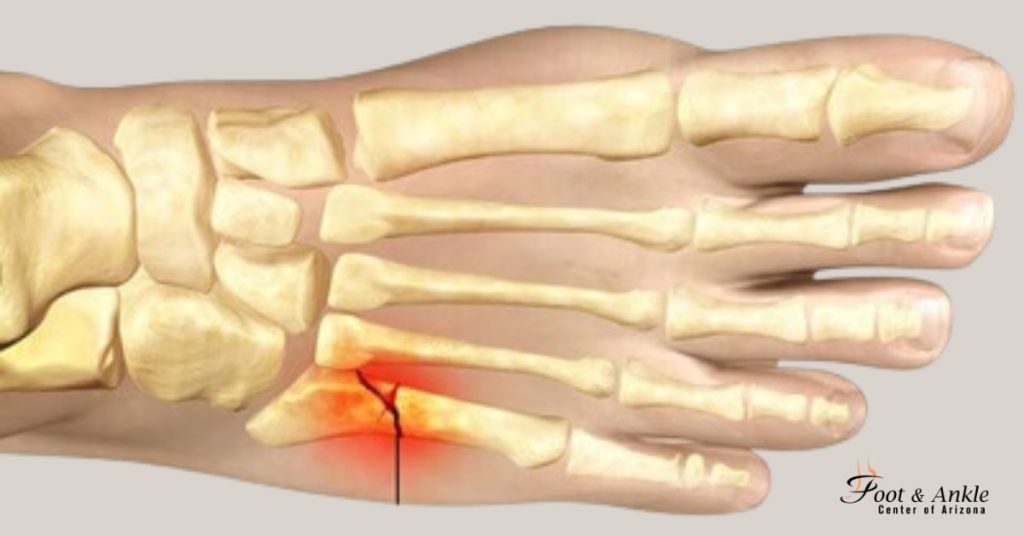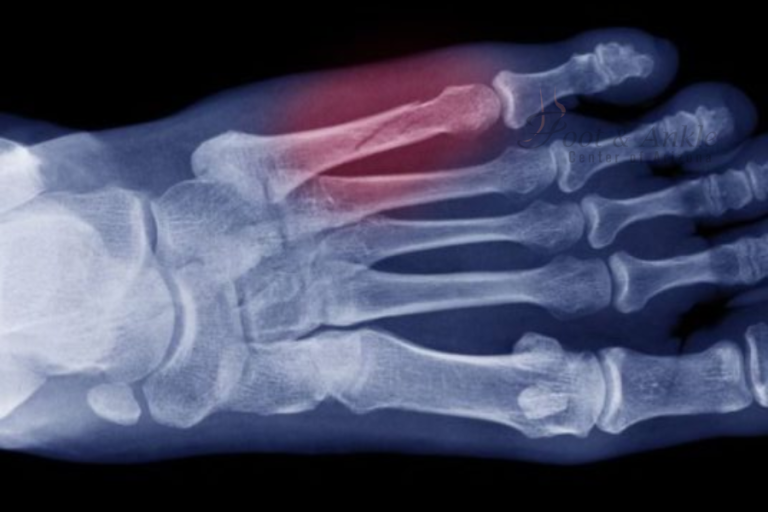Pain on the outside of the foot can be very disturbing and upsetting. If you have been suffering from prolonged pain and the bone on outside of foot hurts, then be assured you are not alone. This type of pain can have several causative factors, generally including injury, infection, or underlying conditions. Understanding this nature and how to bring it under control can be helpful in the alleviation of discomfort and the prevention of consequent complications. This detailed overview explores the possible causes of outside foot pain, treatment options, and how to get relief from it.
Lateral Foot Pain Overview
Lateral foot pain, sometimes known as pain on the outside of the foot, may arise from several different sources. The lateral aspect of the foot involves the fifth metatarsal bone, the cuboid bone, and the tendons and ligaments that cross over it. Some kind of damage or irritation to these structures, then, can cause discomfort and pain. Let us discuss some common reasons and probable treatments for this type of pain.
1. Common Causes of Pain on the Outside of the Foot
a. Stress Fractures
A stress fracture is a small crack in the bone, which often comes as a result of overuse or repetitive stress. The fifth metatarsal bone is located at the outside of the foot, and stress fractures do occur here. Any athlete or any person associated with high-impact sports or activity has a higher risk of this injury.
Signs and Symptoms: The patient presents with sharp pain on the outer side of the foot, mainly while engaged in some physical activity or immediately after it, and generally has an increase in pain by the end of the day with weight-bearing activities.
Treatment: Rest and abstain from activities that bring about the pain. Ice applications and over-the-counter analgesics could help in the management of symptoms. Severe cases might be treated by the use of a boot or casting.
b. Cuboid Syndrome
The cuboid syndrome is defined as a partial dislocation of the cuboid bone located laterally to the foot. Ankle spraining and wearing incorrect footwear are usually the factors responsible for the syndrome.
Symptoms: Pain on the outer side of the foot. Sometimes, swelling of the area can be noticed with difficulty in walking.
Treatment: Treatment generally involves mobilization of the cuboid bone by a physical therapist or a chiropractor, rest, and the use of ice. The patient may also be helped by proper footwear and strengthening exercises for the foot.
c. Peroneal Tendonitis
Peroneal tendons are the two tendons passing behind the lateral malleolus and then along the lateral side of the foot and ankle. If these get inflamed or irritated, the patient is said to be suffering from peroneal tendonitis.
Symptoms: Pain and swelling on the outside of the foot and ankle. Pain with activity, relieved with rest.
Treatment: Rest, ice, and anti-inflammatory medications. Stretching and strengthening exercises for the tendons.
A bunionette, or tailor’s bunion, is a prominence of the fifth metatarsal bone at the base of the little toe. It brings a person a lot of pain and discomfort when it’s on that side of the foot or leg.
Symptoms: The symptoms that an individual feels include a visible bump on the outside of the foot, as well as pain, with redness around the same area.
Treatment: In some other conditions, wearing padding and proper-fitting shoes may help relieve the patient. At times, in severe cases, surgical intervention is needed to remove the bunionette.
2. Infections and Ingrown Toenails
These also would result in pain in the outside of the foot, particularly when the infections become extensive and start spreading to the adjacent regions.
a. Ingrown Toenails
An ingrown toenail refers to the condition in which the nail has stuck inside the surrounding skin, thereby causing both pain and possibly even an infection.
Symptoms: Pain, redness, swelling around the toenail. In severe cases, there may be pus.
Management: Soaking the affected foot in warm soapy water may relieve most of the pain arising from the ingrown toenail. If pus can be seen already, medical attention must be sought since the approach to management centers on draining the infection.
How to Drain Pus from Ingrown Toenail: An ingrown toenail is a condition requiring pus to be drained in case it is infected, such that further complications can be averted. This is to be done only by the professional since one is prone to making it worse when doing it themselves. Small cuts may be made so that pus can freely drain out and prescribe antibiotics if necessary.
b. Infected Toe
An infected toe—whether due to an ingrown toenail or some other origin—can have unbearable pain.
Symptoms: Redness, swelling, pain, and pus or other discharge.
Treatment: Soaking the toe in warm water and application of topical antibiotics can usually be of help. In case severe, oral antibiotics may be necessary. Proper healthcare consultation is very important.
3. Chronic Pain and Long-Term Solutions
Those individuals that have had a case of the outer side foot pain for up to numerous months require more non-invasive means in diagnosing and treatment to establish the root causes of the complication.
a. Proper Footwear
Having proper-fitting, supportive shoes is among the most vital aspects for treating and preventing foot pain. For example, shoes that provide substantial arch support and adequate cushioning can reduce shock and lessen the impact on the foot, alleviating pain.
b. Physiotherapy
A physical therapist will help in creating a personalized exercise program, which will strengthen the muscles around the foot and flexibility and will address any biomechanical issue that is causing the pain
c. Orthotics
Custom orthotics will give extra support and extra alignment for the foot. It will help in reducing the pain and help protect the feet from further injury.
4. WHEN TO SEE THE DOCTOR
Medical attention is required if the pain becomes excruciating or is accompanied by swelling in the foot. If the pain persists and refuses to die down, despite some basic home care, a medical practitioner needs to be consulted. The doctor will examine the patient entirely and may recommend imaging studies, such as X-rays or MRIs, to identify the source of the pain accurately. The doctor will suggest specific treatments to alleviate pain.
5. Preventive and Care
Healthy practices and preventive steps need to be incorporated into daily life for the prevention of exterior foot pain.
a. Regular Foot Care
Regularly inspect your feet for any conditions, such as cuts, blisters, or any unusual growth. Keep feet clean and dry to prevent the chances of infections.
b. Strengthening Exercises
Experts advise that exercises on the foot and ankle are crucial to increasing strength and stability in those parts of the body, hence reducing the likelihood of injuries. These practices include toe raises, ankle circles, and foot stretches.
c. Good Footwear Choices
Select shoes that fit well and provide adequate support for your activities. Avoid wearing high heels or shoes with inadequate cushioning for prolonged periods.
FAQs on Pain on the Outside of the Foot
1. What are some of the common causes of pain on the outer side of your foot?
This pain could indicate various conditions from a stress fracture and cuboid syndrome to peroneal tendonitis and bunionettes. Stress fractures could be due to overuse or repetitive stress on the lower extremity occurring typically in the fifth metatarsal bone. Cuboid syndrome occurs when there is a partial dislocation of the cuboid bone, while peroneal tendonitis happens when the inflammation of tendons occurs on the outer ankle and foot. Bunionettes occur as bony prominences on the fifth metatarsal.
2. How would I know if I have an ingrown toenail, and how would I treat it?
The ingrown toenail develops when the nail’s edge begins to grow into the surrounding skin and cuts it. This results in tenderness, redness, and swelling at the side of the nail. Sometimes there could be the appearance of pus, which means it’s infected. For ingrown toenails, soak the infected foot in warm water with added soap to reduce the inflammation. In the case of pus, medical help should be sought for the proper draining of it, in order to prevent further infection of the area. A minor surgery can be done by a health professional for draining out the pus, along with the prescription, if needed, of antibiotics.
3. How best to manage chronic pain on the outside of the foot?
For months of pain on the outside of your foot, the approach to chronic pain is typically multi-faceted. First, make sure you are wearing appropriate and supportive footwear. Physical therapy can help you to strengthen the surrounding muscles of the foot and help you gain more flexibility. Custom orthotics could give enhanced support and reduce pain as well. If these do not relieve your symptoms, consultation with a healthcare professional would be good for further evaluation and treatment options.
4. How can I prevent infections that cause pain on the outside of the foot?
To avoid infections it is important to keep good foot hygiene and attend in a timely way to the risks that could occur. Inspect your feet regularly for cuts or blisters, and treat any wound at once. Make sure to trim your toenails properly; do not round the corners or cut them too short; in case of ingrown toenails, attend them promptly. If signs of an infection arise, such as redness, swelling, or pus, then you should return to your health care provider right away, so you can prevent the condition from worsening.
5. What are some treatments for peroneal tendonitis causing pain on the outside of the foot?
It is treated by resting the affected foot and avoiding activities that exacerbate the pain in any respect. Support can be developed in the management of symptoms by applying ice temperatures to cool down inflammation as well as anti-inflammatory medications. The physical or occupational therapist may also prescribe exercises to strengthen and stretch the peroneal tendons. In serious cases, advanced treatment may involve the use of orthotic devices and creating an immobilized situation for the foot.
Conclusion
Pain on the outside of your foot can arise from various causes, including stress fractures, cuboid syndrome, peroneal tendonitis, and bunionettes. Additionally, infections and ingrown toenails can contribute to discomfort. Understanding the underlying cause of your pain is essential for effective treatment and relief. If you are in persistent pain, always visit for medication and treatment to get a better diagnosis. In dealing with the source of your pain and executing preventive measures, you can stop by addressing the cause of your pain and have healthy, pain-free feet.
For one-on-one advice and information on treatment options that will most suit you, consult with a healthcare provider who can tailor-make their advice to suit your exact ailment and needs better.





